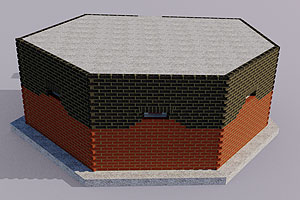A new locality and trench #300!
Posted: 20 October 2009 23:06
An excursion last week saw me finally locate a missing company locality on the Downs - an amazing haul of 31 trenches took me well over the 300 mark.
I knew there was a company dug in somewhere in this area, but the precise location was as yet unknown. A previous visit some months back had found me in a field full of knee-high tufted grass and other vegetation that completely obscured the ground, so I was unusually pleased to make the breakthrough in woodland.
Woods can be a nightmare as I've mentioned previously, the real problem in this area being the presence of numerous fallen trees. An uprooted tree can leave an impression in the ground that is scarily similar to that of a backfilled slit trench.
The photo below shows a pair of trenches.

So am I in danger of listing uprooted tree holes as trenches? Yes, but those features I recorded here as WW2 trenches I did so based on the following reasoning:
- Their size is consistent and conforms to known fieldwork designs
- The alignment and layout fits with each trench, its neighbours and the landscape
- The arrangement fits in with known tactical doctrine
- If these are uprooted trees, then the entire tree, stump and excess spoil has been completely removed whereas far more fallen trees have been left in situ
- There are numerous fallen trees throughout the area but these trenches only appear in distinct areas
The image below shows the greater part of my field sketch. I've coloured the trenches in red, the blue lines mark speculative platoon boundaries, and yellow possible sections. These boundaries are based on the distance between groups of trenches; the spatial layout on the sketch is not to scale. This was an A3 sheet, but it's very hard when you're finding trenches thick and fast to plot them in correct relation to each other; this is why they get closer together as you move from left to right as I was afraid of running out of paper!

There are probably more trenches to be found here though; we don't have enough to accommodate the company that we know was dug in here and all of my speculative platoon localities are seemingly short of trench space.
I'm always wary of headcounts in relation to trench layouts, however. There's a temptation to count trenches and then stop looking for more once enough have been found to house, say, a platoon, but this can trip you up if the occupying unit is not infantry. For example, Royal Engineers, whose company/section/sub-section strengths differ from the infantry equivalents might have more trenches in a locality. Also, whereas by 1941 an infantry section comprised 10 men, many positions that I presume to be section localities have six 2-man slit trenches, not the five you would expect. It's quite likely that extra positions might be dug, perhaps for the 2-inch mortar crew to be detached from platoon HQ and sited in with a section where the weapon was best placed.
So I cautiously estimate that this location has more to be discovered; a subsequent visit revealed no further evidence, so barring the grazing of the long grass and vegetation to the rear of the position, many trenches may remain hidden. Once I've analysed my GPS data and compiled a more accurate scale plan of these trenches, I may have a better idea of where the missing positions may be.
- Pete

Email:
Blog Latest

Bishopstone reveals its pillbox secrets
18 October 2021

Pillbox or Observation Post?
10 June 2020

Uncovering the hidden secrets of a pillbox
8 June 2019

Review of 2018
31 December 2018

Wartime Christmas in East Sussex (2)
24 December 2018
Jargon-buster
Slit trench
Small, narrow trench designed to provide protection against shrapnel and other battlefield hazards. Technically distinct from a weapon pit (which was intended soley as a defensive position) slit trenches were also used as defence works.
This site is copyright © Peter Hibbs 2006 - 2024. All rights reserved.
Hibbs, Peter A new locality and trench #300! (2024) Available at: http://pillbox.org.uk/blog/216643/ Accessed: 27 July 2024
The information on this website is intended solely to describe the ongoing research activity of The Defence of East Sussex Project; it is not comprehensive or properly presented. It is therefore NOT suitable as a basis for producing derivative works or surveys!